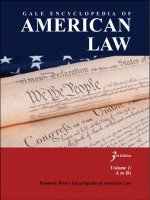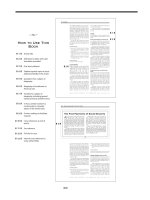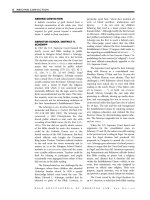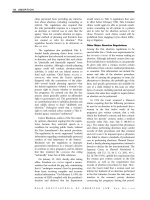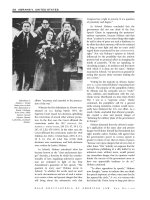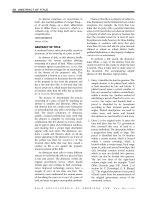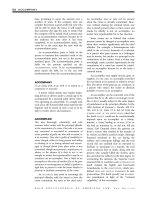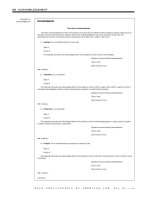Gale Encyclopedia Of American Law 3Rd Edition Volume 1 P42 pdf
Bạn đang xem bản rút gọn của tài liệu. Xem và tải ngay bản đầy đủ của tài liệu tại đây (187.74 KB, 10 trang )
common law, or a statutory assignment, which
is controlled by applicable statutes.
The state statutes require that the assign-
ment be recorded, schedules of assets and
liabilities be filed, notice be given to the
creditors, the assignee be bonded, and the
assignor be supervised by the court. Almost
every jurisdiction prohibits the granting of a
preference. All creditors except those with liens
or statutorily created priorities are treated
equally. Some statutes empower an assignee to
set aside prior fraudulent conveyances, and
others authorize the assignee to set aside
preferences made before the assignment.
If a debtor has made substantial preferences,
fraudulent conveyances, or allowed liens void-
able in
BANKRUPTCY to attach to his or her
property, then creditors might be able to force
the debtor into bankruptcy if they decide that
the assignment does not adequately protect
their rights. An efficiently handled assignment
for benefit of creditors is frequently more
advantageous to creditors than bankruptcy
because it usually brings about better liquida-
tion prices and its less rigid and formal structure
saves time and money.
FURTHER READINGS
Buckley, Mike C., and Gregory Sterling. 2003. “What Banks
Need to Know about ABCs.” Banking Law Journal 120
(January).
Kupetz, David S. 2003. “Assignment for the Benefit of
Creditors: Exit Vehicle of Choice for Many Dot-Com,
Technology, and Other Troubled Enterprises.” Journal
of Bankruptcy Law and Practice 11 (November-
December).
ASSIGNS
Individuals to whom property is, will, or may be
transferred by conveyance, will, descent and
distribution, or statute; assignees.
The term assigns is often found in deeds; for
example, “heirs, administrators, and assigns to
denote the assignable nature of the interest or
right created.”
ASSISTANCE, WRIT OF
A court order issued to enforce an existing
judgment.
ASSISTED SUICIDE
Assisted suicide is the means by which an
individual chooses to end his or her life via the
help of another person, who may either share
relevant medical knowledge or offer medical
assistance. Forms of assisted suicide include active
and passive euthanasia and physician-assisted
suicide.
As a general matter, passive euthanasia is a
generally accepted practice associated with an
individual’s right to refuse medical treatment.
Conversely, active euthanasia and physician-
assisted suicide have traditionally been pro-
scribed throughout the United States, though
movements in a small number of states have
sought to allow terminally ill patients to hasten
death through more active means. As of 2009,
two states have enacted statutes allowing for
assisted suicide, and the issue is being litigated
and otherwise debated in other states.
Physicians abide by the Hippocr atic Oath as
a code of ethics. The oath is: “I will follow that
method of treatment , which, according to my
ability and judgment, I consider for the benefit
of my patients, and abstain from whatever is
deleterious and mischievous. I will give no
deadly medicine to anyone if asked, nor suggest
any such counsel.” The American Medical
Association takes a stance in line with this oath,
strictly forbidding physicians from participating
in assisted suicide because such a practice is
“fundamentally incompatible with the physi-
cian’s role as healer, would be difficult or
impossible to control, and would pose serious
societal risks.”
The majority of states have outlawed
assisted suicide through legislation, while courts
in other states have determined that assisted
suicide is a crime under common law. Since the
1990s, though, several states have considered
proposals to allow terminally ill patients to self-
administer lethal doses of medication pre-
scribed by a doctor.
Jack Kevorkian
The activities of Dr. Jack Kevorkian brought the
issue of assisted suicide to the forefront of
public attention during the 1990s. Kevo rkian
assisted more than 40 people in committing
suicide in Michigan. His first public assisted
suicide took place in 1989, when he assisted in
the suicide of Janet Adkins, who had been
diagnosed with Alzheimer’s disease. Kevorkian
was charged with murder for his involvement in
Adkins’ death. However, because Michigan law
did not specifically forbid a physician from
GALE ENCYCLOPEDIA OF AMERICAN LAW, 3RD E DITION
398 ASSIGNS
assisting a patient in killing herself, the charges
brought against Kevorkian were dismissed.
The Michigan Legislature in 1992 enacted
an assisted-suicide bill that was designed
specifically to prevent Kevorkian’s activities.
However, the bill’s implementation was delayed
due to questions of the legislation’s constitu-
tionality and other technical questions. Kevor-
kian was charged with murder several times, but
prosecutors failed to bring about a judgment.
In 1998 Kevorkian took a more active role
in the death of Thomas Youk, a 52-year-old
Michigan man who had been diagnosed with
amyotrophic lateral sclerosis (ALS). Kevorkian
videotaped himself administering lethal medi-
cation that caused Youk’s death. One week later
CBS broadcast the tape on 60 Minutes. Based on
this evidence, authorities in Michigan charged
Kevorkian with first-degree premeditated mur-
der, criminal assistance of a suicide, and
delivery of a controlled substance for adminis-
tering legal medication to a terminally ill man.
A jury in 1999 found Kevorkian guilty of
second-degree murder in 1999. He was sent to
prison and served eight years of a 10- to 25-year
sentence. He was released in 2007.
Constitutionality of Assisted-Suicide
Statutes
The Supreme Court issued two decisions that
significantly affected the law governing assisted
suicide. In Washington v. Glucksberg (521 U.S.
702, 117 S. Ct. 2258, 138 L. Ed. 2d 772 [1997]),
the Court held that states have the right to
prohibit assisted suicide. The case arose when
three terminally ill patients brou ght an action
against the State of Washington seeking a
declaratory judgment that the state’s ban on
assisted suicide violated the patients’ due
process rights. A unanimous Supreme Court
held that assisted suicide is not a fundamental
liberty interest protected by the due process
clause of the Fourteenth Amendment. Based on
this conclusion, the state only had to prove that
its assisted suicide bore a rational relationship to
a legitimate government interes t. The Court
conclude that the state had met this standard.
In a second case, Vacco v. Quill (521 U.S.
793, 117 S. Ct. 2293, 138 L. Ed. 2d 834 [1997]), a
group of physicians challenged a New York
assisted suicide statute by arguing that the
statute violated the equal protection clause.
Based on its conclusion in the case of
Glucksberg, the Court determined that New York
needed to satisfy the rational basis standard.
Because the state could show a rational relation-
ship between the statute and the interests the
state sought to protect, the Court ruled that
the New York law was constitutional.
The Court in Glucksberg noted that if it
struck down the Washington statute, the Court
would also have to strike down policy choices in
nearly every state. Though the Court allowed
the statute to stand, the decision allowed states
to review the issue to determine whether to lift
or soften the bans on assisted suicide.
Oregon’s Death with Dignity Act
In 1994 Oregon voters approved the state’s
Death with Dignity Act (Or. Rev. Stat. §§
127.800 et seq.), which allows physicians to
assist a terminally ill patient in committing
suicide. Individuals wishing to employ the law
must demonstrate that they are suffering from a
terminal illness and have a life expectancy of six
months or less. The patient must make two oral
requests and one written for assisted suicide.
Moreover, two physicians must be convinced
that the patient is sincere and that the decision
in voluntary. Although court challenges delayed
the statute implementation, the statute took
effect in October 1997. Between 1997 and 2008,
a total of 401 patients took their own lives
through assisted suicide method.
On November 6, 2001, former U.S. attorney
general John Ashcroft issued a ruling that
declared the use of controlled substances for
the purpose of assisted suicide violated the
Controlled Substances Act (CSA) (21 U.S.C. §§
801 et seq.). This ruling, known as the Ashcroft
Directive, reversed the position taken by former
attorney general Janet Reno in 1998. Two days
after the publication of the directive, the state of
Oregon filed suit in federal court against
Ashcroft and other federal officers and agencies.
The U.S. District Court for the District of
Oregon on November 8, 2001, enjoined the
enforcement of the directive.
The CSA includes a schedule of controlled
substances that are available only through
written prescription. In 1971 attorney general
John N. Mitchell issued a regulation that
requires such a prescrip tion to be used “for a
legitimate medical purpose by an in dividual
practitioner acting in the usual course of
his professional practice” (21 C.F.R. § 1306.04
GALE ENCYCLOPEDIA OF AMERICAN LAW, 3RD E DITION
ASSISTED SUICIDE 399
[2005]). Under the CSA, physicians are required
to register with the attorney general, and the
attorney general may deny, revoke, or suspend a
registration when the registration would be
“inconsistent with the public interest” (21 U.S.C.
§§ 822, 824 [2000]).
In issuing the directive, Ashcroft determined
that use of controlled substances for assisted
suicide was not a “legitimate medical purpose.”
U.S. District Judge Robert E. Jones reviewed the
CSA to determine whether Ashcroft had
exceeded his authority in issuing the directive.
According to Jones, Congress did not intend for
the CSA to override a state’s decision regarding
what constitutes the practice of medicine. Since
Ashcroft had acted pursuant to power that he
did not possess, the court determined that his
directive was invalid. Accordingly, the court
entered a permanent in junction that prevented
the directive from taking effect.
The federal government appealed the deci-
sion to the U.S. Court of Appeals for the Ninth
Circuit. In an opinion issued on May 26, 2004,
the Ninth Circuit upheld the district court’s
decision. According to Judge Richard C. Tallman,
who wrote the opinion, not only had Ashcroft
exceeded his authority in issuing the directive,
but also the directive had exercised control over
an area of law that was traditionally reserved to
the states. Unless Congress is “unmistakably
clear,” a unit of federal government may not
exercise this type of control. The Ninth Circuit
thus let the injunction remain in force.
The U.S. Supreme Court granted certiorari
in 200 5 and rendered its decision on January 17,
2006. In an opinion written by Justice Anthony
Kennedy, the ma jority affirmed the Ninth
Circuit’s decision. Kennedy wrote that Ash-
croft’s interpretation of the CSA was not
entitled to deference by the Court because the
CSA only extended limited power to the
attorney general’s office. Moreover, the Court
noted that Ashcroft did not have sufficient
expertise for his rule to be entitled to deference.
According to Kennedy, “[t]he deference here is
tempered by the Attorney General’s lack of
expertise in this area and the apparent absence
of any consultation with anyone outside the
Department of Justice who might aid in a
reasoned judgment.”
The federal government continued to argue
that its power extended to this area through the
provisions of the CSA. Kennedy disagreed
entirely. “The Government, in the end, main-
tains that the prescription requirement dele-
gates to a single Executive officer the power to
effect a radical shift of authority from the States
to the Federal Government to define general
standards of medical practice in every locality,”
Kennedy wrote. “The text and structure of the
CSA show that Congress did not have this far-
reaching in tent to alter the federal-state balance
and the congressional role in maintaining it.”
Accordingly, the Court affirmed the Ninth
Circuit’sjudgment(Gonzales v. Oregon, 546 U.S.
243, 126 S. Ct. 904, 163 L. Ed. 2d 748 [2006]).
According to statistics compiled by the
Oregon Department of Human Services for
2008, the majority of those who took their own
lives through assisted suicide were between the
ages of 55 and 84, with a median age of 72. In
previous years, the median age was slightly
lower. About 80 percent of the patients had
cancer. Smaller numbers of patients have other
diseases such as ALS (also called Lou Gehrig’s
disease) or AIDS.
Other States Consider Assisted
Suicide Proposals
Since the decision in Gonzales v. Oregon, six other
states have considered proposals. On November 4,
2008, voters in the S tate of Washington approved
a ballot measure that legalized assisted suicide. The
statute is modeled on the Oregon statute. In 2008
a Montana trial court ruled that a terminally ill
patient had the constitutional right to receive aid
in dying. The Montana attorney general appealed
the decision to the Montana Supreme Court. On
December 31, 2009, the supreme court ruled that
state law protects doctors from prosecution for
helping terminally ill people die. In the 4-3
decision, the court did not rule on whether
physician-assisted suicide is a right guaranteed
under the Montana Constitution.
FURTHER READINGS
Behuniak, Susan M., and Arthur G. Svenson. 2003.
Physician-Assisted Suicide: The Anatomy of a Constitu-
tional Law Issue. Lanham: Rowman & Littlefield.
Mitchell, John B. 2007. Understanding Assisted Suicide: Nine
Issues to Consider. Ann Arbor: Univ. of Michigan Press.
Wester-Mittan, Candle M. 2009. Physician-Assisted Death:
Four Views on the Issue of Legalizing PAD: A Legal
Research Guide. Buffalo, N.Y.: W.S. Hein.
CROSS REFERENCES
Euthanasia; Suicide
GALE ENCYCLOPEDIA OF AMERICAN LAW, 3RD E DITION
400 ASSISTED SUICIDE
ASSIZE, OR ASSISE
A j udicial procedure in early England whereby a
certain number of men in a community were
called together to hear and decide a dispute; a type
of court. A type of writ, commanding the
convening of such a tribunal in order to determine
disputed rights to possess land. An edict or statute
issued by an ancient assembly.
For example, the Assize of Clarendon was a
statute, or ordinanc e, passed in the tenth year of
the reign of King Henry II (1164). It proclaimed
that those who were accused of a heinous crime
and were unable to exonerate themselves had
forty days to gather provisions from friends to
provide for their sustenance before they were
sent into exile.
The word assize comes from the Latin
assideo, which describes the fact that the men
taking action sat together. An assize could be a
number of citizens, eventually settled at the
number twelve, called to hear cases . They
decided on the basis of i nformation they had
or could gather in the community. This group
of neighbors was presumed to know the facts
well enough to determine who was entitled to
possession of disputed lands. A
WRIT of assize
could be issued on behalf of the king to
commission this body of twelve to hear a
dispute.
Eventually the writs gave birth to
FORMS OF
ACTION
for lawsuits concerning real property.
For example, the assize of novel disseisin was a
form of action for the recovery of lands after the
claimant had been wrongfully dispossessed
(disseised). The assize of
NUISANCE was proper
to secure the
ABATEMENT of a nuisance or for
monetary damages to compensate for the harm
done by the nuisance.
CROSS REFERENCES
Clarendon, Constitutions of; Henry II of England.
ASSOCIATE JUSTICE
The designation given to a judge who is not the
chief or presiding justice of the court on which he
or she sits.
An associate judge is usually a member of an
appellate court.
ASSOCIATION, FREEDOM OF
See FREEDOM OF ASSOCIATION.
ASSOCIATION OF TRIAL LAWYERS
OF AMERICA
See AMERICAN ASSOCIATION FOR JUSTICE.
ASSUMPSIT
[Latin, He undertook or he promised.] A
promise by which someone assumes or undertakes
an obligation to another person. The promise may
be oral or in writing, but it is not under seal. It is
express when the person making the promise puts
it into distinct and specific language, but it may
also be implied because the law sometimes imposes
obligations based on the conduct of the parties or
the circumstances of their dealings.
Assumpsit was one of the common-law
FORMS OF ACTION. It determined the right to sue
and the relief available for someone who
claimed that a contract had been breached.
When the
COMMON LAW was developing in
England, there was no legal remedy for the
breach of a contract.
RANULF GLANVILL, a famous
legal scholar, wrote just before the year 1200
that “[i]t is not the custom of the court of the
lord king to protect private agreements, nor
does it concern itself with such contracts as can
be considered private agreements.” Ordinary
lawsuits could be heard in local courts, but the
king was primarily interested in royal rights and
the disputes of his noblemen. As commerce
began to develop, the king’s courts did allow
two forms of action for breach of contract—the
actions of
COVENANT and debt. Covenant could
be maintained only if the agreement had been
made in writing and under seal and only if the
action of debt was not available. One could sue
on the debt only if the obligations in the
contract had been fully performed and the
breach was no more than a failure to pay a
specific sum of money.
Finally, in 1370, a
PLAINTIFF sought to sue a
DEFENDANT who had undertaken to cure the
plaintiff’s horse but treated it so negligently that
the horse died, and the action was allowed. In
1375 another man was permitted to sue a
surgeon who had maimed him while trying to
cure him. These cases showed a new willingness
to permit a lawsuit for monetary damages
arising directly from the failure to live up to
an agreement. For the next hundred years the
courts began to allow lawsuits for badly
performed obligations but not for a complete
failure to perform what was required by
contract. Unexpectedly, this restriction was
GALE ENCYCLOPEDIA OF AMERICAN LAW, 3RD E DITION
ASSUMPSIT 401
abandoned also, and a new form of action was
recognized by the courts, an action in special
assumpsit for breach of an express agreement.
Special assumpsit gave a new legal right to
parties who could not sue on a debt. Gradually
it became possible to sue in assumpsit if the
defendant owed a debt and then violated a fresh
promise to pay it. This action came to be known
as indebitatus assumpsit, which means “being
indebted, he promised.”
As time passed, courts were willing to
assume that the fresh prom ise had been ma de
and to impose obligations as if it had. This
allowed lawsuits for a whole range of contract
breaches, not just those recognized by an action
on the debt or in special assumpsit. If the
plaintiff could claim that services had been
performed or goods had be en delivered to the
defendant, then the law would assume that the
defendant had promised to pay for them. An y
failure to do so gave the plaintiff the right to sue
in assumpsit. This development allowed such a
wide range of lawsuits based on promises to
private parties that it came to be known as
general assumpsit.
Eventually the right to sue was extended
even to situations where the defendant had no
intention to pay but it was only fair that he or
she be made to do so. This form was called
assumpsit on
QUANTUM MERUIT. Special assumpsit,
general assumpsit (or indebitatus assumpsit), and
quantum meruit are all ex contractu, arising out
of a contract. Their development is the
foundation of our modern law of contracts.
CROSS REFERENCE
Quantum Meruit.
ASSUMPTION
The undertaking of the repayment of a debt or the
performance of an obligation owed by another.
When a purchaser of real property assumes
the
MORTGAGE of the seller, he or she agrees to
adopt the mortgage debt, becoming personally
liable for its full repayment in case of default. If
a
FORECLOSURE sale of the mortgaged property
does not satisfy the debt, the purchaser remains
financially responsible for the outstanding
balance.
In contrast, a purchaser who takes subject to
the seller’s mortgage agrees to repay the
mortgage debt, but that person’s
LIABILITY is
limited only to the amount that the mortgaged
property is sold for in the case of foreclosure. If
the property is sold for less than the mortgage
debt, the mortgag ee must seek the remaining
balance due from the seller, the original
mortgagor.
ASSUMPTION OF RISK
A defense, fact s offered by a party against whom
proceedings have been instituted to diminish a
plaintiff’s cause of action or defeat recovery to an
action in negligence, which entails proving that the
plaintiff knew of a dangerous condition and
voluntarily exposed himself or herself to it.
Under the federal rules of
CIVIL PROCEDURE,
assumption of the risk is an
AFFIRMATIVE DEFENSE
that the DEFENDANT in a NEGLIGENCE action must
plead and prove. The doctrine of assumpti on of
risk is also known as volenti non fit injuria.
Situations that encompass assumption of
the risk have been classified in three broad
categories. In its principal sense, assumption of
the risk signifies that the
PLAINTIFF, in advance,
has consented to relieve the defendant of an
obligation of conduct toward him or her and to
take a chance of injury from a known risk
ensuing from what the defendant is to do or
leave undone. The consequence is that the
defendant is unburdened of all lega l duty to the
plaintiff and, therefore, cannot be held liable in
negligence.
A second situation occurs when the plaintiff
voluntarily enters into some relation with the
defendant, knowing that the defendant will not
safeguard the plaintiff against the risk. The
plaintiff can then be viewed as tacitly or
implicitly consenting to the negligence, as in
the case of riding in a car with knowledge that
the steering apparatus is defective, which
relieves the defendant of the duty that would
ordinarily exist.
In the third type of situation, the plaintiff,
cognizant of a risk previously created by the
negligence of the defendant, proceeds voluntar-
ily to confront it, as when he or she has been
provided with an article that the plaintiff knows
to be hazardous and continues to use after the
danger has been detected. If this is a voluntary
choice, the plaintiff is deemed to have accepted
the situation and assented to free the defendant
of all obligations.
In all three situations, the plaintiff might be
acting in a reasonable manner and not be
GALE ENCYCLOPEDIA OF AMERICAN LAW, 3RD E DITION
402 ASSUMPTION
negligent in the venture, because the advantages
of his or her conduct outweigh the peril. The
plaintiff’s decision might be correct, and he or
she might even act with unusual circumspection
because he or she is cognizant of the danger that
will be encountered. If that is the case, the
defense operates to refute the defendant’s
negligence by denying the duty of care that
would invoke this
LIABILITY, and the plaintiff
does not recover because the defendant’s
conduct was not wrongful toward the plaintiff.
With respect to the second and third
situations, however, the plaintiff’s conduct in
confronting a known risk might be in itself
unreasonable, because the danger is dispropor-
tionate to the advantage the plaintiff is pursuing,
as when, with other transportation available, the
individual chooses to ride with an intoxicated
driver. If this occurs, the plaintiff’s conduct is
a type of contributory negligence, an act or
omission by the plaintiff that constitutes a
deficiency in ordinary care, which concurs with
the defendant’s negligence to comprise the direct
or
PROXIMATE CAUSE of injury. In such cases, the
defenses of assumption of risk and contributory
negligence overlap.
In this area of interse ction, the courts have
held that the defendant can employ either
defense or both. Because ordinarily either is
sufficient to bar the action, the defenses have
been distinguished on the theory that assump-
tion of risk consists of awareness of the peril
and intelligent submission to it, while contribu-
tory negligence entails some deviation from the
standard of conduct of a
REASONABLE PERSON,
irrespective of any remonstration or unaware-
ness displayed by the plaintiff. The two concepts
can coexist when the plaintiff unreasonably
decides to incur the risk or can exist indepen-
dently of each other. The distinction, when one
exists, is likely to be one between risks that were
in fact kno wn to the plain tiff and risks that the
individual merely might have discovered by the
exercise of ordinary care.
Express Agreement
The parties can enter into a written agreement
absolving the defendant from any obligation of
care for the benefit of the plaintiff and liability
for the consequence of conduct that would
otherwise constitute negligence. In the ordinary
case,
PUBLIC POLICY does not prevent the parties
from contracting in regard to whether the
plaintiff will be responsible for the maintenance
of personal safety. A person who enters into a
lease or rents an animal or enters into a variety
of similar relations entailing free and open
bargaining between the parties can assent to
relieving the defendant of the obligation to take
precautions and thereby render the defendant
free from liability for negligence.
The courts have refused to uphold such
agreements, however, if one party possesses a
PATENT disadvantage in bargaining power. For
example, a contract exempting an employer from
all liability for negligence toward employees is
void as against public policy. A carrier transport-
ing cargo or passengers for hire cannot evade its
public responsibility in this manner, even though
the agreement limits recovery to an amount less
than the probable damages. The contract has
been upheld, however, when it represents a
realistic attempt to assess a value as liquidated or
ascertained damages in advance, and the carrier
graduates its rates in accordance with such value,
so that complete protection would be available to
the plaintiff upon paying a higher rate. The same
Visitors to
professional sporting
events assume the risk
that they may be
injured by
competitors or game
paraphernalia during
the contest.
KEVORK DJANSEZIAN/
GETTY IMAGES
GALE ENCYCLOPEDIA OF AMERICAN LAW, 3
RD E DITION
ASSUMPTION OF RISK 403
principles apply to innkeepers, public ware-
housemen, and other professional bailees—such
as garage, parking lot, and checkroom atten-
dants—on the basis that the indispensable
necessity for their services deprives the customer
of all meaningful equal bargaining power.
An express agreement can relieve the
defendant from liability for negligence only if
the plaintiff comprehends its terms. If the
plaintiff is not cognizant of the provision in
his or her contract, and a reasonable person in
the same position would not have known of it,
it is not binding upon the individual, and the
agreement fails for lack of mutual assent. The
expressed terms of the agreement must apply to
the particular misconduct of the defendant.
Such contracts generally do not encompass
gross, willful,
WANTON, or reckless negligence or
any conduct that constitutes an intentional tort.
Implied Acceptance of Risk
In a majority of cases, the consent to assume the
risk is implied from the conduct of the plaintiff
under the circumstances. The basis of the
defense is not contract, but consent, and it is
available in many cases in which no express
agreement exists.
By entering voluntarily into any relationship
or transaction in which the negligence of the
defendant is evident, the plaintiff is deemed to
accept and consent to it, to assume responsibil-
ity for personal safety, and to unburden the
defendant of the obligation. Spectators at
certain sports events assume all the known risks
of injury from flying objects. Plaintiffs who
enter business premises as invitees and detect
dangerous conditions can be deemed to assume
the risks when they continue voluntarily to
encounter them.
Knowledge of Risk
The plaintiff will not normally be regarded as
assuming any risk of either conditions or
activities of which he or she has no knowledge.
The plaintiff must not merely create the danger
but must comprehend and appreciate the
danger itself.
The applicable standard is basically subjec-
tive in nature, tailored to the particular plaintiff
and his or her situation, as opposed to the
objective standard of the reasonable person of
ordinary prudence, which is employed in
contributory negligence. If because of age, lack
of information, or experience, the plaintiff does
not comprehend the risk entailed in a known
situation, the individual will not be regarded as
consenting to assume it. Failure to exercise
ordinary care to discover the danger is not
encompassed within assumption of risk, but in
the defense of contributory negligence.
An entirely subjective standard, however,
allows the plaintiff considerable latitude in
testifying that he or she did not know or
comprehend the risk. To counteract the adverse
effects of the application of this liberal standard,
courts have interjected an objective element by
holding that a plaintiff cannot evade responsibil-
ity by alleging that he or she did not comprehend
a risk that must have been obvious.
A denial of cognizance of certain matters that
are common knowledge in the community is not
credible, unless a satisfactory explanation exists.
As in the case of negligence itself, there are
particular risks that any adult must appreciate,
such as falling on ice, lifting heavy objects, and
driving a defective vehicle. In addition, a plaintiff
situated for a considerable length of time in the
immediate vicinity of a hazardous condition is
deemed to have detected and to comprehend the
ordinary risks entailed in that situation. If the
person completely understands the risk, the fact
that he or she has temporarily forgotten it does
not provide protection.
Even when there is knowledge and appre-
ciation of a risk, the plaintiff might not be
prohibited from recovery when the circum-
stances introduce a new factor. The fact that the
plaintiff is totally cognizant of one risk, such as
the speed of a vehicle, does not signify that he or
she assumes another of which he or she is
unaware, such as the intoxication of the driver.
Although knowledge and understanding of
the risk incurred are encompassed within the
concept of assumption of the risk, it is possible
for the plaintiff to assume risks of whose specific
existence he or she is unaware—to consent to
venture into unknown conditions. In a majority
of instances, the undertaking is express, although
it can arise by implication in a few cases. A guest
who accepts a gratuitous ride in an automobile
has been regarded as assuming the risk of defects
in the vehicle, unknown to the driver.
Voluntary Assumption
The doctrine of assumption of risk does not
bar the plaintiff from recovery unless the
GALE ENCYCLOPEDIA OF AMERICAN LAW, 3RD E DITION
404 ASSUMPTION OF RISK
individual’s decision is free and voluntary.
There must be some manifestation of consent
to relieve the defendant of the obligation of
reasonable conduct. A risk is not viewed as
assumed if it appears from the plaintiff’s words
or from the circumstances, that he or she does
not actually consent. If the plaintiff relinquishes
his or her better judgment upon assurances that
the situation is safe or that it will be remedied or
upon a promise of protection, the plaintiff does
not assume the risk, unless the danger is so
patent and so extreme that there can be no
reasonable reliance upon the assurance.
Even when the plaintiff does not protest, the
risk is not assumed when the conduct of the
defendant has provided the individual with no
reasonable alternative, causing him or her to act
under duress. When the defendant creates a
peril, such as a burning building, those who
dash into it to save their own property or the
lives or property of others do not assume
the risk when the alternative is to permit the
threatened injury to occur. If, however, the
danger is disproportionate to the value of
the interest to be protected, the plaintiff might
be charged with contributory negligence in
regard to his or her own unreasonable conduct.
When a reasonably safe alternative exists, the
plaintiff’s selection of the hazardous route is
free and can constitute both contributory
negligence and assumption of risk.
The defendant has a legal duty, which he or
she is not at liberty to refuse to perform, to
exercise reasonable care for the plaintiff’s safety,
so that the plaintiff has a parallel legal right to
demand that care. The plaintiff does not assume
the risk while using the defendant’s services or
facilities, notwithstanding knowledge of the
peril, when he or she acts reasonably, and the
defendant has provided no reasonable al terna-
tive other than to refrain completely from
exercising the right. A
COMMON CARRIER or other
public utility which has negligently furnished a
dangerously defective set of steps cannot assert
assumption of risk against a patron who uses
the steps as the sole convenient means of access
to the company’s premises. The same principle
applies to a city maintaining a public roadway
or sidewalk or other public area that the
plaintiff has a right to use and premises onto
which the plaintiff has a contractual right to
enter. When a reasonable alternative is available,
the plaintiff’s recalcitrance in unreasonably
encountering danger constitutes contributory
negligence, as well as assumption of risk.
Violation of Statute
The plaintiff still assumes the risk where the
defendant’s negligence consists of the violation
of a statute. A guest who accepts a nighttime
ride in a vehicle with inoperative lights has been
regarded as consenting to relieve the defendant
of the duty of complying with the standard
established by the statute for protection and
cannot recover for injuries. Particular statutes,
however, such as child labor acts and safety
statutes for the benefit of employees, safeguard
the plaintiff against personal inability to protect
himself or herself due to improvident judgment
or incapability to resist certain pressures. Since
the basic objective of such statutes would be
frustrated if the plaintiff were allowed to assume
the risk, it is generally held that the plaintiff
cannot do so, either expressly or impliedly.
Abolition of the Defense
Numerous states have abrogated the defense of
assumption of risk in automobile cases through
the enactment of no-fault insurance legislation
or comparative negligence acts. The theories
underlying its abolition are that it serves no
purpose that is not completely disposed of by
the other doctrines, it increases the likelihood of
confusion, and it bars recovery in meritorious
cases.
Assumption of risk is not a defense under
state workers’ compensation laws or in federal
Employer’s Liability Act actions. The workers’
compensation laws abolished the defense in
recognition of the severe economic pressure a
threatened loss of employment exerted upon
workers. A worker was deemed to have assumed
the risk even when acting under a direct order
that conveyed an explicit or implicit threat of
discharge for insubordination.
The federal Employers’ Liability Act (45 U.S.
C.A. § 51 et seq. [1908]) was intended to furnish
an equitable method of compensation for
railroad workers injured within the scope of
their employment. The act provides that an
employee is not deemed to have assumed the
risks of employment when injury or death
ensued totally or partially from the negligence
of the carrier’s officers, agents, or employees, or
from the carrier’s violation of any statute
enacted for the safety of employees, where the
infraction contributed to the employee’s injury
GALE ENCYCLOPEDIA OF AMERICAN LAW, 3RD E DITION
ASSUMPTION OF RISK 405
or death. This doctrine was abolished because of
the extreme hardship it imposed on workers in
this dangerous line of employment.
FURTHER READINGS
Drago, Alexander J. 2002. “Assumption of Risk: An Age-Old
Defense Still Viable in Sports and Recreation Cases.”
Fordham Intell. Prop. Media & Ent. Law Journal 12
(winter).
Gilles, Susan M. 2002. “From Baseball Parks to the Public
Arena: Assumption of the Risk in Tort Law and
Constitutional Libel Law.” Temple Law Review 75
(summer).
Owen, Richard. 2000. Essential Tort. 3d ed. London:
Cavendish, Ltd.
Rabin, Robert L. 2003. Perspectives on Tort Law. Frederick,
MD: Aspen.
Simons, Kenneth W. 2002. “Reflections on Assumption of
Risk.” UCLA Law Review 50 (December).
CROSS REFERENCES
Cognizance; Consent; Insurance; Public Utilities; Reason-
able Person.
ASSURED
A person protected by insurance coverage against
loss or damage sti pulated by the provisions of a
policy purchased from an insurance company or
an underwriter.
Assured is synonymous with
INSURED.
ASYLUM
Protection granted to aliens who cannot return to
their homeland.
Asylum is not to be confused with refuge,
although the terms are sometimes used inter-
changeably. An alien who wishes to emigrate to
another country is granted refugee status before
leaving his or her native country. An asylum
seeker (or asylee) seeks that status after arriving
in the new country.
People who live in fear of being tortured or
killed by their government often seek asylum, as
do people who are persecuted for their religious
or political beliefs. The United States has long
been a haven for asylum seekers; in colonial
days people came to America to escape religions
persecution, and in later years people in danger
of political torture have seen the United States
as a place of hope and safety. In times of crisis,
the United States has sometimes placed restric-
tions on who can enter the country.
IMMIGRATION
restrictions were enacted immediately after
World Wars I and II. The September 11th
terrorist attacks on New York City and
Washington, D.C., likewise changed the picture
for immigration. Nonetheless, the United States
remains co mmitted to providing a safe haven
for people whose governments intend to do
them harm.
Asylum in the United States is regulated
under Section 208 of the Immigration and
Nationality Act (INA), which was passed in
1952 and has been amended periodically
afterward. Previously, asylum matters were
handled by the Immigration and
NATURALIZATION
Service (INS). The Homeland Security Act of
2002 created three new agencies to handle all
matters formerly handled by the INS. These
new agencies, the Bureau of Citizenship and
Immigration Services (BCIS); the Bureau of
Customs and Border Protection; and the
Bureau of Immigration and Customs Enforce-
ment were made part of the
HOMELAND SECURITY
DEPARTMENT
that became operational in March
2003. Although the BCIS was technically a new
agency, it was to continue to conduct all
business, including processing applications and
requests, as the INS had.
Eligibility for Asylum
People who can prove that they will be
persecuted if they are returned to their home
country can apply for asylum in the United
States. Much persecution is based on race,
RELIGION, and politics, but there are other
reasons as well. Students are frequently targeted
for persecution, particularly if they choose to
engage in social or political activism. Women in
some countries may be subject to severe
punishment (including execution) simply for
having a baby out of wedlock. Homosexuals are
persecuted in a number of countries, especially
those in which religion is an integral part of the
government.
People with a criminal record including
aggravated feloni es (i.e., serious crimes such as
RAPE and MURDER) are generally no t eligible for
asylum, nor are those who have been found
guilty of subversive activity against government
agencies. Waivers are difficult to obtain; a
person would need to provide substantive and
irrefutable proof that he or she had been
wrongfully or falsely charged by his or her
government. Those who have communicable
diseases or who have physical or mental
disorders are ineligible for asylum unless they
can provide proof that their condition is either
cured or under control. Some people come to
GALE ENCYCLOPEDIA OF AMERICAN LAW, 3RD E DITION
406 ASSURED
the United States to seek better job opportu-
nities. Those people are not candidates for
asylum; they are required to follow standard
immigration procedures.
A person can seek asylum in the United
States either through affirmative asylum or
defensive asylum. In affirmative asylum, the
person applying submits the proper paperwork
(known as Form I-589) to the BCIS and is
called to appear before an asylum officer for an
interview. In defensive asylum, the person in
question has been placed in removal proceed-
ings by the Immigration Court and has to
appear before an immigration judge from the
Executive Office for Immigration Review
(EOIR). Those who seek defensive asylum
include undocumented
ALIENS who have been
caught entering the country illegally, but who
also may be genuinely afraid of being persecuted
if they are sent home. Asylum officers often
refer undocumented aliens to EOIR for a
defensive hearing if they feel that the fear of
persecution is credible.
Article 3 of the
UNITED NATIONS Convention
Against Torture (1999) states that no asylum
seeker can be returned home if the threat of
torture is strong enough. The BCIS does have
the option, however, of sending an unsuccessful
asylum seeker to a third country in which there
is no danger of torture or persecution.
Derivative Asylum
Often asylum seekers want protection not just
for themselves but also for their families.
Anyone seekin g asylum may include a spouse
and children under the age of 21 on the I-589
form. Derivative asylum is designed to give that
same option to people who have already been
granted asylum. Stepchildren are eligible if the
applicant and spouse married before the child’s
18th birthday; adopted children must have been
adopted before their 16th birthday, and the
applicant must have been a legal parent for at
least two years. Asylum seekers have two years
from the date they are granted asylum to apply
for derivative asylum.
Temporary Protected Status
In some cases, an alien in the United States may
choose to obtain “Temporary Protected Status”
(TPS). Typically, TPS is granted by the
DEPART-
MENT OF JUSTICE
to aliens whose home country is
unsafe due to such causes as armed conflict or
natural disaster. TPS generally lasts from six to
18 months; when TPS status terminates, the
aliens generally return to the same immigration
status they held before the status was granted.
The R-A Rule
In 1999 the Bureau of Immigration Affairs
(BIA) ruled against an asylum seeker in In re
R-A-, 22 I. & N. Dec. 906, Interim Decision
(BIA) 3403, 2001 WL 1744475 (BIA, Jan 19,
2001). In the initial case, Ms. Rody Alvarado
Pena was granted asylum by a San Francisco
immigration judge in 1996 because she had
suffered years of
DOMESTIC VIOLENCE from her
Guatemalan husband. In June 1999 the BIA
reversed the immigration judge’s decision and
ordered Ms. Alvarado to be deported to
Guatemala. The BIA ruled against gr anting
asylum, in part because it saw domestic violence
as a private matter within her own family,
despite Ms. Alvarado’s argument that she was,
in fact, a member of a persecuted group. (She
belonged to a support group for abused women.)
The decision led to the denial of many women
seeking asylum protection who were fleeing from
a wide range of
HUMAN RIGHTS violations, includ-
ing trafficking for
PROSTITUTION, honor killing,
and domestic violence. In January 2001 Attorney
General
JANET RENO ordered the BIA to issue a new
decision in Ms. Alvarado’s case after the Depart-
ment of Justice issued new regulations on the
issue of gender asylum. The Department of
Justice consulted with experts in domestic
violence and noted its position that certain forms
of domestic violen ce may indeed constitute
persecution. For example, if a country’s domestic
violence laws were weak or ineffective against
protecting abused spouses, that could be con-
strued as a public issue, not merely a private one
within individual families.
In 2005, du ring the
GEORGE W. BUSH admin-
istration, Attorney General
JOHN ASHCROFT
reviewed the BIA’s decision, vacated Reno’s
decision, and ordered that the parties involved
in the case brief the case again (i.e., submit new
legal arguments). The
DEPARTMENT OF HOMELAND
SECURITY
at that time stated in its brief that it
supported Ms. Alvarado’s request for asylum
and indicated that final regulations regarding
the subject of gender asylum were under
consideration. However, the regulations were
never finalized. Accordingly, in September
2008 Attorney General
MICHAEL MUKASEY ordered
the BIA to reconsider the case, and removed
the requirement that the BIA wait for the
GALE ENCYCLOPEDIA OF AMERICAN LAW, 3RD E DITION
ASYLUM 407

